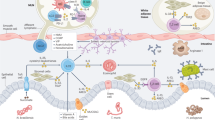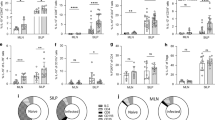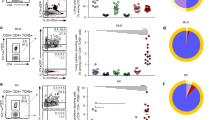Abstract
Innate lymphoid cells (ILCs) are lymphocyte-like cells that lack T cell or B cell antigen receptors and mediate protective and repair functions through cytokine secretion. Among these, type 2 ILCs (ILC2 cells) are able to produce type 2 cytokines. We report the existence of an inflammatory ILC2 (iILC2) population responsive to interleukin 25 (IL-25) that complemented IL-33-responsive natural ILC2 (nILC2) cells. iILC2 cells developed into nILC2-like cells in vitro and in vivo and contributed to the expulsion of Nippostrongylus brasiliensis. They also acquired IL-17-producing ability and provided partial protection against Candida albicans. We propose that iILC2 cells are transient progenitors of ILCs mobilized by inflammation and infection that develop into nILC2-like cells or ILC3-like cells and contribute to immunity to both helminths and fungi.
This is a preview of subscription content, access via your institution
Access options
Subscribe to this journal
Receive 12 print issues and online access
$209.00 per year
only $17.42 per issue
Buy this article
- Purchase on Springer Link
- Instant access to full article PDF
Prices may be subject to local taxes which are calculated during checkout







Similar content being viewed by others
References
Walker, J.A., Barlow, J.L. & McKenzie, A.N. Innate lymphoid cells–how did we miss them? Nat. Rev. Immunol. 13, 75–87 (2013).
Spits, H. & Cupedo, T. Innate lymphoid cells: emerging insights in development, lineage relationships, and function. Annu. Rev. Immunol. 30, 647–675 (2012).
Spits, H. et al. Innate lymphoid cells–a proposal for uniform nomenclature. Nat. Rev. Immunol. 13, 145–149 (2013).
Moro, K. et al. Innate production of TH2 cytokines by adipose tissue-associated c-Kit+Sca-1+ lymphoid cells. Nature 463, 540–544 (2010).
Neill, D.R. et al. Nuocytes represent a new innate effector leukocyte that mediates type-2 immunity. Nature 464, 1367–1370 (2010).
Price, A.E. et al. Systemically dispersed innate IL-13-expressing cells in type 2 immunity. Proc. Natl. Acad. Sci. USA 107, 11489–11494 (2010).
Saenz, S.A. et al. IL25 elicits a multipotent progenitor cell population that promotes TH2 cytokine responses. Nature 464, 1362–1366 (2010).
Saenz, S.A. et al. IL-25 simultaneously elicits distinct populations of innate lymphoid cells and multipotent progenitor type 2 (MPPtype2) cells. J. Exp. Med. 210, 1823–1837 (2013).
Fallon, P.G. et al. Identification of an interleukin (IL)-25-dependent cell population that provides IL-4, IL-5, and IL-13 at the onset of helminth expulsion. J. Exp. Med. 203, 1105–1116 (2006).
Chang, Y.J. et al. Innate lymphoid cells mediate influenza-induced airway hyper-reactivity independently of adaptive immunity. Nat. Immunol. 12, 631–638 (2011).
Motomura, Y. et al. Basophil-derived interleukin-4 controls the function of natural helper cells, a member of ILC2s, in lung inflammation. Immunity 40, 758–771 (2014).
Salimi, M. et al. A role for IL-25 and IL-33-driven type-2 innate lymphoid cells in atopic dermatitis. J. Exp. Med. 210, 2939–2950 (2013).
Monticelli, L.A. et al. Innate lymphoid cells promote lung-tissue homeostasis after infection with influenza virus. Nat. Immunol. 12, 1045–1054 (2011).
McHedlidze, T. et al. Interleukin-33-dependent innate lymphoid cells mediate hepatic fibrosis. Immunity 39, 357–371 (2013).
Nussbaum, J.C. et al. Type 2 innate lymphoid cells control eosinophil homeostasis. Nature 502, 245–248 (2013).
Wilhelm, C. et al. An IL-9 fate reporter demonstrates the induction of an innate IL-9 response in lung inflammation. Nat. Immunol. 12, 1071–1077 (2011).
Magri, G. et al. Innate lymphoid cells integrate stromal and immunological signals to enhance antibody production by splenic marginal zone B cells. Nat. Immunol. 15, 354–364 (2014).
Boos, M.D., Yokota, Y., Eberl, G. & Kee, B.L. Mature natural killer cell and lymphoid tissue-inducing cell development requires Id2-mediated suppression of E protein activity. J. Exp. Med. 204, 1119–1130 (2007).
Hoyler, T. et al. The transcription factor GATA-3 controls cell fate and maintenance of type 2 innate lymphoid cells. Immunity 37, 634–648 (2012).
Yagi, R. et al. The transcription factor GATA3 is critical for the development of all IL-7Rα-expressing innate lymphoid cells. Immunity 40, 378–388 (2014).
Wong, S.H. et al. Transcription factor RORα is critical for nuocyte development. Nat. Immunol. 13, 229–236 (2012).
Yang, Q. et al. T cell factor 1 is required for group 2 innate lymphoid cell generation. Immunity 38, 694–704 (2013).
Spooner, C.J. et al. Specification of type 2 innate lymphocytes by the transcriptional determinant Gfi1. Nat. Immunol. 14, 1229–1236 (2013).
Hwang, Y.Y. & McKenzie, A.N. Innate lymphoid cells in immunity and disease. Adv. Exp. Med. Biol. 785, 9–26 (2013).
Mjösberg, J.M. et al. Human IL-25- and IL-33-responsive type 2 innate lymphoid cells are defined by expression of CRTH2 and CD161. Nat. Immunol. 12, 1055–1062 (2011).
Guo, L. et al. IL-1 family members and STAT activators induce cytokine production by Th2, Th17, and Th1 cells. Proc. Natl. Acad. Sci. USA 106, 13463–13468 (2009).
Licona-Limón, P., Kim, L.K., Palm, N.W. & Flavell, R.A. TH2, allergy and group 2 innate lymphoid cells. Nat. Immunol. 14, 536–542 (2013).
Gladiator, A., Wangler, N., Trautwein-Weidner, K. & LeibundGut-Landmann, S. Cutting edge: IL-17-secreting innate lymphoid cells are essential for host defense against fungal infection. J. Immunol. 190, 521–525 (2013).
O'Shea, J.J. & Paul, W.E. Mechanisms underlying lineage commitment and plasticity of helper CD4+ T cells. Science 327, 1098–1102 (2010).
Acknowledgements
We thank J. Zhu for critical reading of the manuscript; J. Edwards for assistance in the preparation of sorter-purified cells; L. Feigenbaum of the SAIC Laboratory Animal Sciences Program for injection of the recombinant bacterial artificial chromosome into oocytes, transfer into pseudopregnant females and screening of pups; C. Dong (MD Anderson Cancer Center) for IL-17F–RFP reporter mice; A. McKenzie (MRC Laboratory of Molecular Biology, Cambridge) for Il1rl1−/− mice; and members of Laboratory of Immunology at NIAID for discussions. Supported by the NIAID Division of Intramural Research (US National Institutes of Health).
Author information
Authors and Affiliations
Contributions
Y.H. and W.E.P. designed and interpreted the experiments and wrote the manuscript; L.G. assisted with the experiments and read the manuscript; Y.H. did the experiments; J.Q. did the C. albicans oral infection; X.C. generated 4C13R mice; J.H.-L. assisted with cell culture and flow cytometry; U.S. provided Il17rb−/− mice; P.R.W. assisted in the design and interpretation of experiments with C. albicans; and J.F.U. provided N. brasiliensis and helped to design and interpret experiments with N. brasiliensis.
Corresponding author
Ethics declarations
Competing interests
The authors declare no competing financial interests.
Integrated supplementary information
Supplementary Figure 1 iILC2 cells are induced in several sites of mice by IL-25 treatment.
Wild-type B6 mice were treated i.p. with PBS or IL-25 daily for 3 days and leukocytes form various tissues were isolated and analyzed by flow cytometry for ST2, KLRG1 and lineage markers expression. Cells were gated from Lin–. Data are representative of two independent experiments (n=3 mice for each group in each experiment).
Supplementary Figure 2 A portion of nILC2 cells in naive mice produce IL-13.
(a) Map of recombined BAC transgene for 4C13R dual reporter mice. LCR, TH2 locus control region. (b) Lung leukocytes from wild-type B6 or 4C13R mice were isolated and analyzed by flow cytometry for expression of lineage, Thy1, ST2, KLRG1, AmCyan and DsRed. nILC2s were gated on Lin–Thy1hiST2+KLRG1int cells. Data are pooled from three independent experiments (n=6 wild-type mice, n=8 4C13R mice).
Supplementary Figure 3 iILC2–derived nILC2-like cells do not re-express IL-25 receptors upon IL-2 signaling.
iILC2s sorted from IL-25-treated Rag2–/– mice were cultured in IL-7 and IL-33 for 3 days, and then cells were stimulated with IL-2, or with IL-2 plus IL-25, for 2 days. IL-17RB expression was measured by flow cytometry. Data are representative of two independent experiments (n=3 cell culture wells for each condition in each experiment).
Supplementary Figure 4 iILC2 cells produce IL-13 and become nILC2-like cells during N. brasiliensis infection.
(a) 4C13R mice were infected with N. brasiliensis for various days and lung leukocytes were isolated and analyzed by flow cytometry for lineage, Thy1, KLRG1, AmCyan and DsRed expression. nILC2s were gated on Lin–Thy1hiKLRG1int (red) and iILC2s were gated on Lin–Thy1low KLRG1hi (blue). (b) 4 ×104 nILC2s sorted from naïve CD45.1 Rag1–/– mice or 20 ×104 iILC2s sorted from IL-25-treated CD45.1 Rag1–/– mice were transferred into Rag2–/–Il2rg–/– mice, which were infected with N. brasiliensis. 14 days later, transferred cells in the lung were analyzed by flow cytometry for expression of CD45.1, KLRG1, ST2 and Thy1. Data are representative of two independent experiments in a, b (n=3 mice for each group in each experiment of a, n=2 recipient mice in each experiment of b).
Supplementary Figure 5 Both IL-17-producing and non–IL-17-producing iILC2 cells can develop into IL-17–IL-13 double producers in vitro.
iILC2s, from IL-25-treated IL-17-RFP mice, were stimulated with PMA plus ionomycin and then were divided into RFP+ and RFP– populations through cell sorting. The purified populations were cultured in either “TH2” conditions or “TH17” conditions for 7 days. IL-13 and IL-17 production was measured by intracellular staining after 6-hour stimulation with PMA plus ionomycin. Data are representative of two independent experiments (n=3 cell culture wells for each condition in each experiment).
Supplementary Figure 6 nILC2 cells have less ability than iILC2 cells to develop into IL-17 producers.
nILC2s (sorted from naïve Rag2–/– mice) and iILC2s (sorted from IL-25-treated Rag2–/– mice) were cultured in various conditions as indicated. 7 days after culture, cells were stimulated with PMA plus ionomycin for 6 hours and the production of IL-13 and IL-17 were determined by intracellular cytokine staining. Data are representative of two independent experiments (n=2 cell culture wells for each condition in each experiment).
Supplementary Figure 7 C. albicans oral infection elicits ILCs in cervical lymph nodes.
Rag2–/– mice were infected sublingually with C. albicans for 5 days and leukocytes from cervical LNs were analyzed by flow cytometry for expression of lineage, Thy1, IL-7Rα, c-Kit, IL-17RB, ST2, and KLRG1. ILCs were gated as Lin–IL-7Rα+Thy1+. Data are representative of two independent experiments (n=3 mice for each group in each experiment).
Supplementary information
Supplementary Text and Figures
Supplementary Figures 1–7 (PDF 3530 kb)
Rights and permissions
About this article
Cite this article
Huang, Y., Guo, L., Qiu, J. et al. IL-25-responsive, lineage-negative KLRG1hi cells are multipotential ‘inflammatory’ type 2 innate lymphoid cells. Nat Immunol 16, 161–169 (2015). https://doi.org/10.1038/ni.3078
Received:
Accepted:
Published:
Issue Date:
DOI: https://doi.org/10.1038/ni.3078
This article is cited by
-
Cooperation of ILC2s and TH2 cells in the expulsion of intestinal helminth parasites
Nature Reviews Immunology (2024)
-
The emerging family of RORγt+ antigen-presenting cells
Nature Reviews Immunology (2024)
-
A diversity of novel type-2 innate lymphoid cell subpopulations revealed during tumour expansion
Communications Biology (2024)
-
Virulence factors and mechanisms of paediatric pneumonia caused by Enterococcus faecalis
Gut Pathogens (2023)
-
Butyrate inhibits iILC2-mediated lung inflammation via lung-gut axis in chronic obstructive pulmonary disease (COPD)
BMC Pulmonary Medicine (2023)



